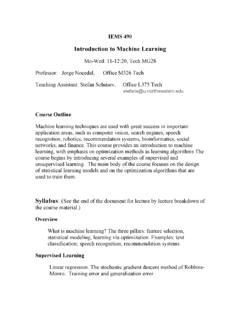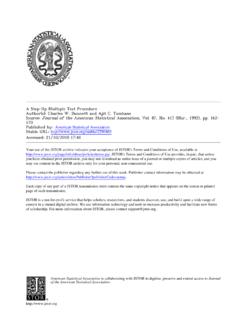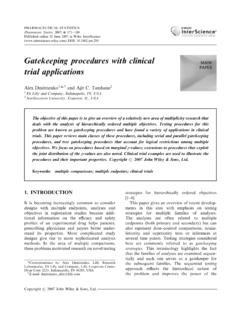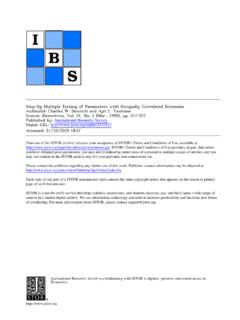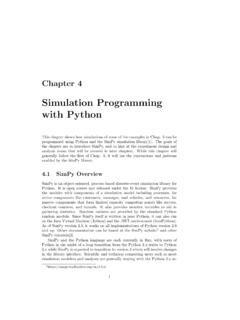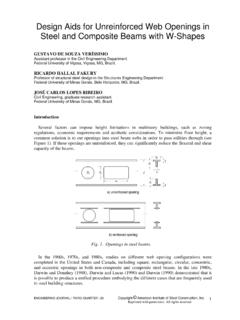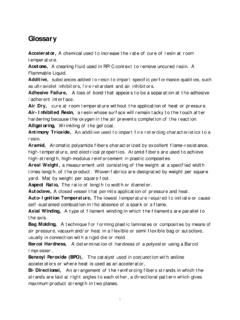Transcription of A composite statistical test for detecting changes …
1 A composite statistical Test for detecting changes of Steady States A statistical procedure for determining whether process variables have undergone a change of steady states is developed by using a com- posite statistical test. Factors influencing the power of the test and the probability of Type I errors were studied through theoretical analysis, computer simulation, and application to plant data. They include the number of variables to be tested together, the number of measurements used in time averaging, the levels of significance of the tests , and the appropriate formulation of the hypotheses. The procedure developed here is useful in process data reconciliation and in applications that require an analysis of process trends.
2 S. Narasimhan, R. S. H. Mah, and A. C. Tamhane Northwestern University Evanston, IL 60201 J. W. Woodward, J. C. Hale E. I. du Pont de Nemours and Company Engineering Department Wilrnington, DE 19898 Introduction Steady state is one of the most important and common assumptions made about a process. Depending on whether this assumption is made, an entirely different treatment of the pro- cess may follow. Much of the pilot plant data for process model- ing and process design is collected when steady state conditions are attained. Preliminary data are taken only for the purpose of ascertaining the state of the operating conditions. Likewise, pro- cess data for plant material and energy balances and yield accounting are normally taken under presumed conditions of steady state.
3 On the other hand, in some applications changes of process conditions are the very essence of the analysis. Process dynamics is obviously central to process control applications. But the detection of steady states can also be useful in historical data recording. Hale and Sellars (1981) have proposed and imple- mented various heuristic algorithms for data compression to reduce the storage required for process data without losing trend information about the process behavior. In data compression schemes, data are recorded only when their numerical values undergo significant changes . In their schemes the magnitude of significant changes are prespecified. But detection of a change of steady states could provide an alternative procedure that takes into account the variability in the data in determining when the changes are significant.
4 In process data reconciliation and estimation the treatment is different depending on whether steady state conditions are assumed. For steady state processes the estimation procedure Correspondence concerning this paper should be addressed to R. S. H. Mah (Mah, 1982; Tamhane and Mah, 1985) take no account of past data. But for quasi-steady state processes the stirnation tech- nique utilizes past data as well as steady state material and energy conservation constraints (Stanley and Mah, 1977). In all of the foregoing applications it is important to be able to determine whether a process is in a steady state. In a strict sense steady state conditions almost never prevail in practice.
5 A judg- ment is made by the process engineer or operator as to when a steady state is supposedly attained. Previous work in this area has been limited. In this paper we propose a statistical procedure for determining if a change of steady states has occurred. In our investigation a change in steady state is considered to take place if one or more of the true values of the measured pro- cess variables undergo a change . Notice that in this model the variability in the measurements as given by the measurement error covariance matrix may change without affecting a change of steady states. A combination of multivariate statistical tests is used to detect changes in the state of the variables using mea- surements on these variables.
6 The variables are grouped together based on the knowledge that they are physically related and on the expectation that they are likely to change their states together. The measurements are assumed to be sampled at regu- lar time intervals. A set of N successive measurement vectors constitutes a period, and N is referred to as the period size. It is assumed that a change of steady states may occur from one period to the next, but that within each period the process is in a steady state. The tests are based on sample statistics computed for each time period. Computer simulation, theoretical analysis, and application to plant data are used to arrive at the following main conclusions of this study: The method proposed appears to provide a practica- AIChE Journal September 1986 Vol.
7 32, No. 9 1409 ble approach for detecting changes in steady states. Application to plant data indicates that the test should be formulated such that only when the combined change of the true values of the variables exceeds a prespecified threshold amount, should a change of steady states be assumed to take place. Selection of the variables to be tested together is an important consideration. The power of the composite test to detect a change in the state of the variables increases as we increase the number of variables to be tested together, provided these variables change their states simultaneously. The strategy of application of the test depends on how the process is expected to change states.
8 The strategy proposed in this study is intended for quasi-steady state pro- cesses (Stanley and Mah, 1977). Model and Assumptions In this study process variables are considered to be in a steady state if their true values do not change with time. Our aim is to detect changes in the state of the variables given their measure- ments. The following assumptions are made in this regard: (a) All process variables are measured directly. (b) Measurements contain only random errors, which are normally distributed with mean c. (c) A time period is defined to consist of a set of N successive measurement vectors. Within each period the process variables are assumed to be steady.
9 (d) The covariance matrix of measurement errors is assumed to be unknown and is allowed to change from one period to the next. (e) Successive measurement vectors are assumed to be mu- tually independent. Using these assumptions, the measurement model can be described by - uki - "(0, QJ i = I, 2,.. , N E[c&jgb] = 2 for all i,j, k, 1 with either i # j or k # 1 (3) Here the subscript k refers to the kth period, xk is the vector of true values, .&is the ith vector of measurements in the kth peri- od, and is the corresponding normally distributed vector of random errors with mean 0 and covariance matrix Q&. Thus the Zki are independently distributed as (4) Assumptions (c) and (e) allow us to use the sample covariance matrix as an estimate of Qk.)
10 The estimate of Qk is more compli- cated if steady state conditions are not assumed (Almasy and Mah, 1984). Test Procedure Let us consider consecutive time periods k and k + 1. Let us also consider a group of p variables that are chosen to be tested simultaneously. The test for a change in the true values of the variables has two forms, depending on whether the covariance matrices in the two periods are equal. The proposed test proce- dure proceeds in two stages. In the first stage we apply a test to determine whether the covariance matrices Qk and Qk+1 are equal. Depending on the outcome of this test we apply the appro- priate test in the second stage to determine whether the true vectors Ek and &&+I are equal.
